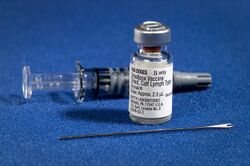Biology:Smallpox Vaccination Campaign of 2003

The Smallpox Vaccination Campaign of 2003 was a vaccination program announced by the White House on 13 December 2002 as preparedness for bioterrorism using smallpox virus. The campaign aimed to provide the smallpox vaccine to those who would respond to an attack, establishing Smallpox Response Teams and using DryVax (containing the NYCBOH strain) to mandatorily vaccinate half a million American military personnel, followed by half a million health care worker volunteers by January 2004. The first vaccine was administered to President Bush.[2][3][4][5]
The campaign ended early in June 2003, with only 38,257 civilian health care workers vaccinated, after several hospitals refused to participate due to the risk of the live virus infecting vulnerable patients and skepticism about the risks of an attack, and after over 50 heart complications were reported by the CDC. That August, the US Institute of Medicine (IOM) criticized the programme for its costs and not considering other bioterrorism control measures such as surveillance.[6][5] The adverse cardiac events, including two deaths, were however unlikely to have been caused by the vaccine.[7] A 2005 IOM report noted that some of the problems of the campaign stemmed from administration officials overruling scientific advice on the numbers who should be vaccinated and a lack of communication by the CDC of the public health need, though it found that the campaign had increased general preparedness for infectious disease outbreaks like monkeypox and SARS.[8]
References
- ↑ "Details - Public Health Image Library(PHIL)". https://phil.cdc.gov/details.aspx?pid=2674.
- ↑ Richards, Edward P.; Rathbun, Katharine C.; Gold, Jay (July 2004). "The Smallpox Vaccination Campaign of 2003: Why Did it Fail and What are the Lessons for Bioterrorism Preparedness?". Louisiana Law Review 64: 851–904. https://www.researchgate.net/publication/228125599.
- ↑ Connolly, Ceci (13 April 2003). "U.S. Smallpox Vaccine Program Lags". The Washington Post. https://www.washingtonpost.com/archive/politics/2003/04/13/us-smallpox-vaccine-program-lags/17a9854c-03b4-4fd5-94de-d6f11d2241f2/.
- ↑ Parrino, Janie; Graham, Barney S. (1 December 2006). "Smallpox vaccines: Past, present, and future" (in en). Journal of Allergy and Clinical Immunology 118 (6): 1320–1326. doi:10.1016/j.jaci.2006.09.037. ISSN 0091-6749. PMID 17157663. https://www.jacionline.org/article/S0091-6749(06)02013-6/pdf.
- ↑ 5.0 5.1 Bartlett, John; Borio, Luciana; Radonovich, Lew; Mair, Julie Samia; O'Toole, Tara; Mair, Michael; Halsey, Neil; Grow, Robert et al. (1 April 2003). "Smallpox Vaccination in 2003: Key Information for Clinicians". Clinical Infectious Diseases 36 (7): 883–902. doi:10.1086/374792.
- ↑ Mackenzie, Debora (22 August 2003). "US smallpox vaccination plan grinds to a halt". New Scientist. https://www.newscientist.com/article/dn4074-us-smallpox-vaccination-plan-grinds-to-a-halt/.
- ↑ "Cardiac Deaths After a Mass Smallpox Vaccination Campaign --- New York City, 1947". MMWR (CDC) 52 (39): 933-936. 3 October 2003. https://www.cdc.gov/mmwr/preview/mmwrhtml/mm5239a1.htm.
- ↑ Kaiser, Jocelyn (3 March 2005). "Report Faults Smallpox Vaccination Campaign". Science. https://www.sciencemag.org/news/2005/03/report-faults-smallpox-vaccination-campaign.

